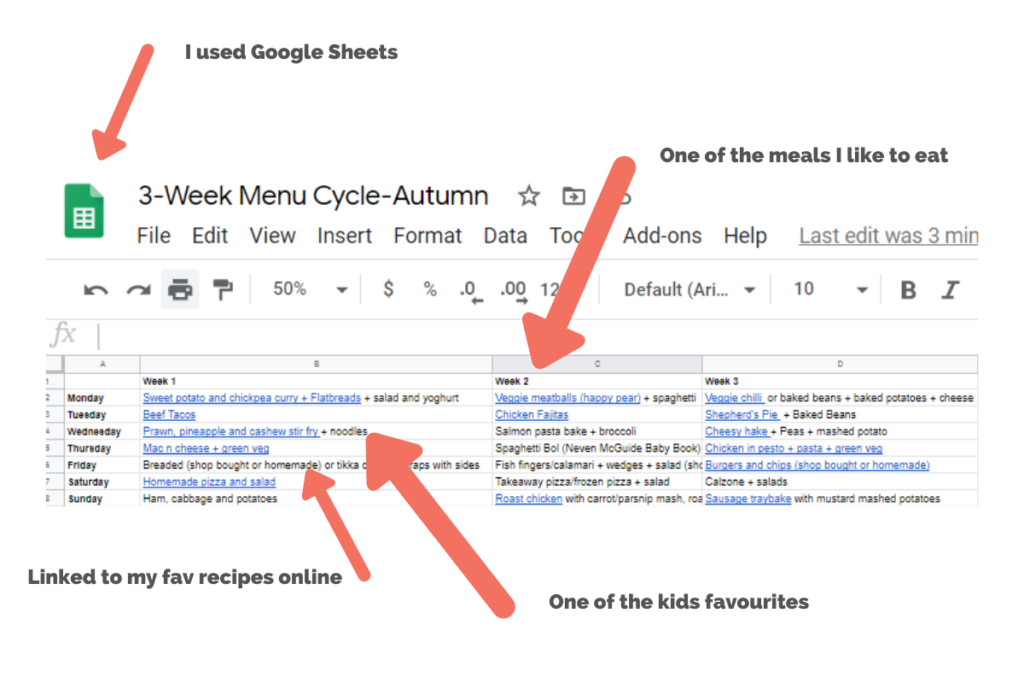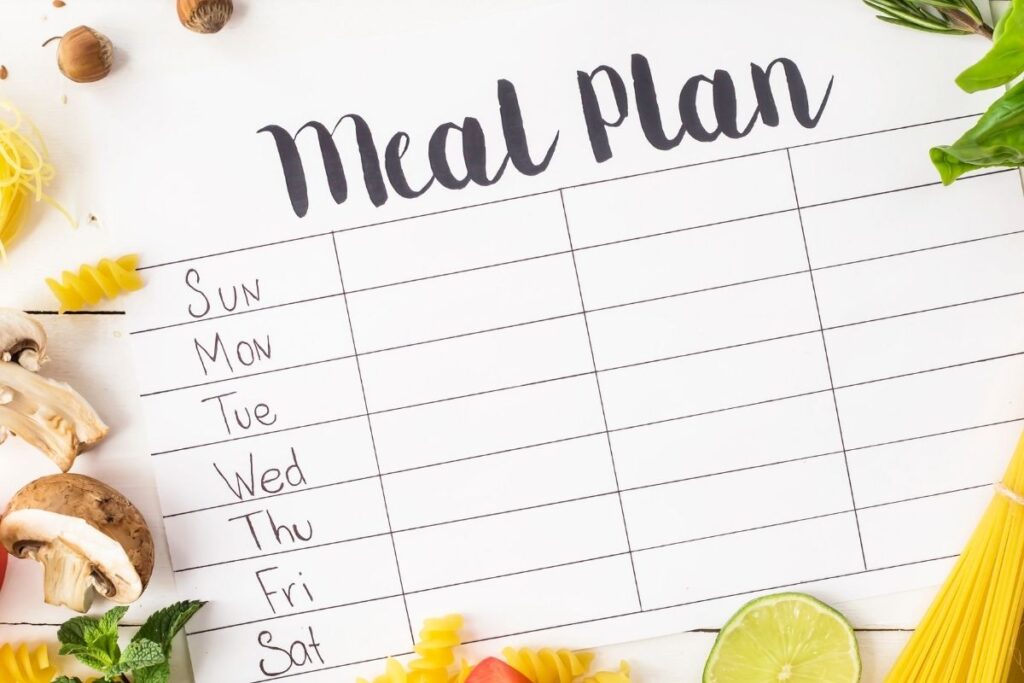28, 000 is roughly the number of meals you’ll prepare for your child! Meal planning can help ease the burden.
We know family meals are important but that doesn’t mean it’s easy to get dinner on the table every night. Especially when you’re juggling work, after-school activities and maybe a small baby too. And this is where meal planning for the family helps.
Meal planning might not be exciting, but there are lots of benefits!
It might be boring, but as the saying goes, fail to prepare, and prepare to fail! Planning for your family’s meals will help you to:
- Ensure that you’re offering a balance of foods throughout the week
- Realistically plan dinners around your commitments.
- Make one meal for the whole family rather than making multiple options.
- Stay within your budget.
- End mealtime battles!
- Save your time allowing you to spend more precious time with (and away from!) your family.
Six steps to easy family meal planning
While there are lots of fancy apps and paper planners out there, meal planning isn’t that difficult! So, try not to overthink it!
Tip 1: Decide one a time span
Write out the days of the week in a special planner, back of an envelope or on your phone! You can plan for the whole seven days or just five days ahead depending on how often you like to shop and whether you want to eat out/get takeaway etc.
Tip 2: Be realistic
Consider your commitments for the week ahead and be realistic. There’s no point planning the ‘perfect’ dinner for the night you’re rushing home from work and then out to soccer!
Tip 3: Aim for balance
Choose a protein food; this could be meat, chicken, fish (white or oily), lentils, tofu, beans, egg or cheese. If you’re a meat-eating family then plan for a mix of protein foods during the week, maybe one meatless night, two fish nights (one oily fish) with meat on the others. If you’re vegetarian or vegan, then take care to plan a good variety of plant-based proteins (iron-rich types preferably) throughout the week.
Add a starchy side. Preferably whole grain but it’s okay to have ‘white’ varieties too. Think potatoes (any way you like them), rice, pasta, couscous, quinoa or just plain old bread. That’s always a reliable one in our house!
Add at least one veggie side: this could be cooked fresh veggies, tinned or frozen veggies or salad. There’s no problem with keeping this simple. Chopping up some cucumber or opening a tin of beans will do the job.. Just make sure to vary this every day and aim to serve the rainbow over the week.
Add a fruity dessert: Rather than finish with fruit, I offer fruit alongside the main meal because it doesn’t matter to me if the kids eat the strawberries before the chicken! Again, this doesn’t need to be elaborate, open a tin of fruit, slice up some apples and serve with a yoghurt dip (we love Greek Yogurt mixed with some almond butter), or if you have the time make a simple crumble with some frozen fruit.
MORE IDEAS HERE >>>Is dessert every night OK for kids
Tip 4: Be considerate but don’t cater
Make sure there’s at least one food on the table that you know each child can eat if they’re hungry. So for example, if you’re confident that they’ll eat the meat then serve with a veggie, they’re not keen on. Another day if you’re serving their favourite pasta pair it with the fish they don’t love yet. Get the drift?! On some days, they may only eat the starchy food and the fruit, but that’s fine. It’s not realistic for everyone to like every food on the table every night.
READ MORE >>> The Division of Responsibility-the ONE feeding strategy you need
Tip 5: Make it a family affair
Get the family involved- ask them for suggestions too. You don’t have to take all their ideas on board that week, but you can tell them when you will put it on the menu. Every time I ask my kids what they’d like, they either say pizza from our local takeaway or macaroni cheese. Much as I’m happy to eat both of these meals, I don’t want to serve, cook or eat these every week. So, instead, I work them into the schedule from time to time.
Tip 6: Accept imperfection!
Don’t aim for perfection! Not every meal needs to be insta-worthy. Mine certainly isn’t! And we regularly eat fish fingers, peas and chips. But served alongside some fresh fruit and some milk even this meal ticks off the main food groups, and as we don’t eat this every night, I’m okay with that!
And you don’t have to fakeaway (I detest that word!); you can also take away! It’s okay to want a break from cooking so don’t feel guilty for the occasional takeaway or meal out. It’s great to make your own ‘chipper meal’ or curry, but it’s also lovely not to have to wash and clear up!
Next level meal planning for the family
- Preventing decision fatigue-I’m sick of racking my brain every Sunday to come up with the weekly meal plan and starting my shopping list from scratch every time.
- Encouraging familiarity and predictability-I’m easily influenced to try new recipes or food. And while this is fine for me because I’m an adventurous eater, two of my children are quite selective and I’m not sure it’s necessarily helping them. Because while it’s good to offer your child variety even if they are ”fussy”, it’s also essential that they regularly see the same foods so that they can learn to like them over time.
- Making it easier for others to step in with cooking and shopping (my husband!)
- Reducing space in my cupboards and freezer by not stocking those ‘just in case’ foods
- Perfecting the old reliables-If I make the same meals more regularly I’m hoping to finally get them off pat. I might even finally perfect homemade pizza dough. Although I’m not holding out too much hope for that one!

Here’s what to do:
- Decide on a theme for each day and come up with a bunch of ideas for each day. Here’s what I came up with but you can come up with any themes you like.
- Monday: Meatless
- Tuesday: Mexican or Mince
- Wednesday: Something fishy
- Thursday: Perfect for pasta
- Friday: Take it easy
- Saturday: Pizza
- Sunday: Roast or traybake
- Make a list of the meals that you and your partner like to eat, the kids like to eat, and those you’d like to try.
- Create a table showing three weeks (I used Google Sheets)
- Slot one meal from the kid’s list into each week (under the relevant theme)
- Do the same with the adult’s favourite meals.
- Work the others in around this (aiming for balance and variety over the week as well as all of the considerations I’ve listed above in the basic plan).
- Try not to have two days in a row of main dishes that ALL the kids don’t like.
- Next (this is genius!), link the dishes to recipes that you like online.
- Finally, generate your shopping list for each week. You can then add the rest of your shopping to this every week. I’ve shared the Google Sheet with my husband, so there’s no excuse now for him to do the shopping! And I have it on my phone so I’ll never leave the list at home again!
Adapting family meals for your baby
Weaning is about getting your baby to learn to like foods your family enjoy and not special baby products and baby recipes! You can adapt most recipes to make them suitable for babies under one.

- Once cooked, most family meals can be pureed, mashed, finely chopped or served as finger foods.
- Avoid adding salt (this includes regular stock cubes or stockpots, soya sauce, fish sauce and gravy) to foods until you’ve taken out your baby’s portion. Also, watch out for foods and commercial foods which are high in salt. Read more about salt and your baby.
- Avoid foods with added free sugars; this includes added table sugar, maple syrup, agave, coconut sugar, fruit puree, fruit concentrates and fruit juices. Read more about sugar and your baby.
- Herbs and spices are fine, but be careful with hot spices like chilli. Use it in small amounts and gradually build up the heat over time.
- Soup recipes, especially those containing lentils, beans, make great dishes for babies. Use low salt stock and add less liquid, and they make a great puree or mash. Your baby can then eat this off a spoon or thin with milk and serve from an open cup.
- Dishes cooked slowly, either in the oven or in a slow cooker are a great way to include meat in your baby’s diet as the meat becomes very tender after a long slow cook.
- You can use a mixture of whole grain and non-whole grain foods like bread, pasta, cereals. If you fill your baby up with too much fibre, they may not get the calories they need to grow.
- Have some meals in the freezer for those nights when the family meal isn’t suitable or is challenging to adapt.
Are you about to start weaning your baby? If so, check out my online Baby Weaning Course








0 Comments